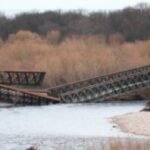The discovery of round-leaved bryum at a reservoir near Edinburgh sparks hope for its conservation
A critically endangered moss species, known as round-leaved bryum, has been found growing at a reservoir near Edinburgh for the first time in 13 years. The moss, which has a distinctive round shape and forms dense cushions on wet rocks, is one of the rarest plants in the UK and has only been recorded at four other locations in Scotland.
The moss was spotted by Dr David Long, a bryologist and honorary research associate at the Royal Botanic Garden Edinburgh (RBGE), who was conducting a survey of the reservoir as part of a project funded by Scottish Water. He said he was “delighted and astonished” to see the moss, which he had not seen since 2010.
“It was a very exciting moment. I recognised it immediately and I was very surprised because it’s such a rare species. It’s a bit like finding a needle in a haystack,” he said.
The moss is threatened by habitat loss, climate change and invasive species
Round-leaved bryum is classified as critically endangered in the UK and is listed as a priority species for conservation under the UK Biodiversity Action Plan. It is also considered internationally important, as the UK holds more than 90% of the global population.

The main threats to the moss are habitat loss, climate change and invasive species. The moss prefers cool, moist and shady conditions and is sensitive to changes in water quality and quantity. It is also vulnerable to competition from other plants, especially non-native species such as Himalayan balsam and rhododendron.
Dr Long said the reservoir where the moss was found was a “very special place” for bryophytes, the group of plants that includes mosses, liverworts and hornworts. He said the reservoir had a “rich diversity” of bryophytes, including some other rare and threatened species.
He said the reservoir was managed by Scottish Water for drinking water supply and that the company had been “very supportive” of the bryophyte survey and conservation work. He said the reservoir was fenced off from the public and that the moss was protected by law.
The moss could be reintroduced to other suitable sites to boost its population
The discovery of round-leaved bryum at the reservoir raises hope that the species could be reintroduced to other suitable sites to boost its population and genetic diversity. Dr Long said he had collected some samples of the moss for further study and propagation at RBGE.
He said he hoped to grow more plants in the laboratory and then transplant them to other locations where the moss had been recorded in the past or where the habitat was suitable. He said he had already identified some potential sites in Scotland and England.
He said the reintroduction of the moss would require careful planning and monitoring, as well as collaboration with landowners and conservation agencies. He said the ultimate goal was to ensure the long-term survival of the species in the wild.
“It’s a very challenging task, but it’s also very rewarding. It’s a beautiful and fascinating plant and it deserves our attention and care. It’s part of our natural heritage and we have a responsibility to protect it,” he said.


















